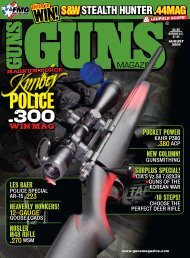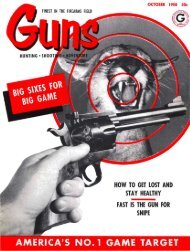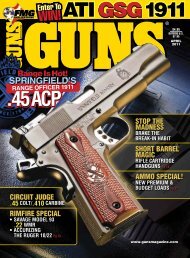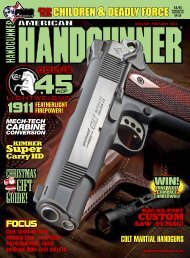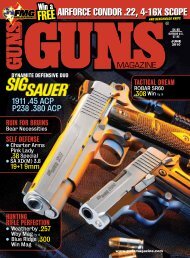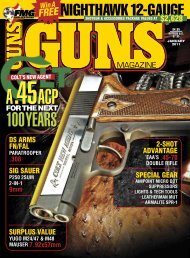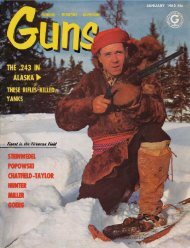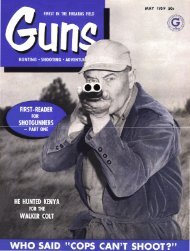NEW! - Jeffersonian
NEW! - Jeffersonian
NEW! - Jeffersonian
Create successful ePaper yourself
Turn your PDF publications into a flip-book with our unique Google optimized e-Paper software.
~; .'<br />
..<br />
..<br />
~<br />
••• ,•. ••<br />
,.;.~..<br />
·lli.<br />
•<br />
Eight different.41 Avenger 'oads printed these 25-yard machine rest groups, averaging<br />
on'y 1. 19 inch. They show potentia' match accuracy of the Avenger.<br />
nitely more controllable than the same cine<br />
using A5 ACP with loads ofsimilar power.<br />
In fact, I fired one 2.2 inch group and several<br />
other good ones, and I don't shoot that<br />
well. Then I got down to serious bench<br />
testing, knowing that my pistolstnithing<br />
had produced a smooth, reliable gun.<br />
TEST FIRING<br />
Mounting the gun in a Lee machine rest,<br />
I fired five-shot groups on a reversed target<br />
at 25 yards, clocking each shot over the<br />
Oehler Model 33 Chronotach Skyscreens.<br />
I have confidence in the Lee rest and my<br />
ability to turn out reliable, repeatable results<br />
with it.<br />
The first group was 1.56 inch, measured<br />
center-to-center ofthe widest hits. Then<br />
they began to get even better: 1.38 inch and<br />
1.20 inch. The fourth was 2.12 inch, but it<br />
was definitely overpressured,judging from<br />
the primer cratering. In fact, several of<br />
these loads caused cratering of the CCI<br />
# 350 magnum large pistol primers.<br />
The first four loads were in full-length<br />
A5 Winchester Magnum brass; then I<br />
switched to a series in old Federal A5 ACP<br />
cases, expecting poorer accuracy.<br />
Here are the groups which followed, in<br />
order: 1.51 inch, .89 inch, 1.25 inch, 1.36<br />
inch, 84 'inch, 1.16 inch, 1.43 inch, and 1.11<br />
inch. Eight straight groups and all different<br />
loads with two· different bullets. And all<br />
grouped into 1.5 inch or less. That may be<br />
the best series of diverse handloads ever<br />
fired from a big-bore semi-auto. The ve-<br />
locities ranged from a mild 854 feet per<br />
second to a hot 1,287 fps.<br />
Hand cyCling shows chambering of a .41<br />
Avenger round in a Co't automatic.<br />
Only one conclusion was possibl~: the<br />
Al Avenger is a great caliber. In later firing,<br />
I have seen nothing to lower that opinion.<br />
If anything, it has become even more<br />
solid.<br />
I also made a load with a 21O-grain cast<br />
semi-wadcutter; it printed a 1.5l-inch<br />
group. The average size for all 13 groups<br />
fired that day was a splendid l.33-inch.<br />
.,That is far better than many custom accurized<br />
.45s will average with factory<br />
match ammo.<br />
Such results cannot be accidental, or<br />
lucky. One or two lucky groups, yes. But<br />
13? Everything has to be just right. Yet, I<br />
had done nothing beyond my usual handloading<br />
and test-firing methods. There is<br />
no reason why most any other shooter<br />
could not h~ve done as well, using the<br />
same hardware and methods.<br />
VARIOUS LOADS<br />
Now, let's consider specific handloads,<br />
picked to show the versatility, power a,nd<br />
accuracy of the Avenger. My favorite bullet<br />
in this caliber is Sierra's nO-grain jacketed<br />
hollow-cavity (JHC), because it is<br />
very accurate and it can be pushed to maximum<br />
power with mild recoil. For instance,<br />
a nice medium load was 6.5 grains<br />
of Winchester 231 powder in Federal A5<br />
ACP brass with CCI # 350 magnum large<br />
pistol primers. This gave that fine .89-inch<br />
group at 1,027 fps. Winchester 231 is cleanburning<br />
and often yields exceptional accuracy.<br />
In the same brass, 7.0 grains made<br />
the .84-inch group at 1,072 fps. These loads<br />
have fine target potential, but I have yet to<br />
confirm or optimize them.<br />
The maximum charge ofWinchester 231<br />
with the Sierra nO-grain JHC bullet was<br />
7.5 grains in my gun, in .45 Winchester<br />
Magnum-type cases. CCI # 350 primers<br />
are a bit soft for this load and cratered too<br />
much; even so, the load clocked 1,162 fps<br />
and I had two groups of 1.38 inch and 1.34<br />
inch yielding 510 foot pounds of muzzle<br />
energy. With harder CCI #200 rifle primers,<br />
the cratering was nil and the same<br />
charge gave 1,155 fps and produced a 1.54<br />
inch group; but eight grains was too hot.<br />
Although all the loads listed here are<br />
based on SSK data, my velocities were definitely<br />
higher than the data indicated, and<br />
my maximum reasonable charges were<br />
smaller. This points up again that heavy<br />
loads must be worked up carefully for each<br />
gun.<br />
The differences were so sizable and consistent<br />
that they require comment. A major<br />
factor undoubtedly is temperature. My firing<br />
was done in 80-90 degree summer<br />
weather, and each degree adds 2-3 fps to<br />
velocity. Also, the chamber and bore ofmy<br />
gun may be tighter than the original barrel<br />
used for the SSK tests.<br />
Mild cratering of primers is acceptable,<br />
although such loads should be limited to<br />
stronger, full-length brass-not the weaker<br />
A5 ACP cases. I had no blown primers or<br />
brass; but it is possible that some cases<br />
might bulge or blowout in the unsupported<br />
area around the extraction groove.<br />
None of my cases bulged, but brass does<br />
vary in strength and resiliency.<br />
The use of harder primers, such as<br />
Winchester-Western's (W-W) 7M-l1lF<br />
magnum large pistol or CCI # 200 rifle<br />
primers, is best for heavy loads. Heavier<br />
gun springs also help to prevent primrr<br />
cup extrusion into the firing pin hole. For<br />
the heaviest loads, I substituted Wolff<br />
springs in my Gold Cup: a 22-pound recoil<br />
spring, a 28-pound hammer spring, and an<br />
extra-power firing pin spring. The gun<br />
would not cycle with light loads, but the<br />
springs protect it and make acceptable<br />
loads out of touchy ones.<br />
Continued on page 77<br />
AMERICAN HANDGUNNER . JANUARYIFEBRUARY 1983 61




